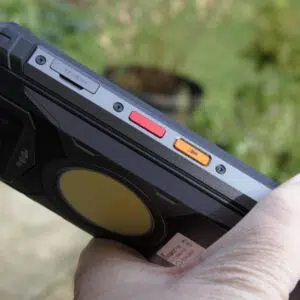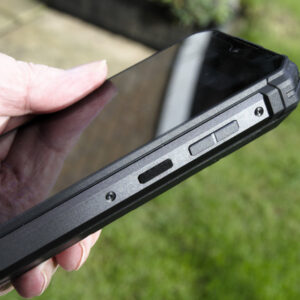


















Fossibot F102: 30-second review
Over the past year, a Tsunami of rugged smartphones built using the MediaTek Helio G99 SoC has struck, and the Fossibot F102 is yet another example.
This one has 12GB of RAM, which can be tweaked up to 20GB using RAM expansion technology, and 256GB of storage. We’ve seen less, and Fossibot didn’t cheap out on either of those or the main camera sensor.
The 108MP Samsung S5KHM2SPO3 is an excellent sensor capable of taking images up to 9000 x 12000 pixels and video up to 1440k. Alongside that is a 5MP Macro and a 20MP night vision sensor.
None of this design is especially unique, but the back of the F102 does have an impressive 3W camping LED that can illuminate some distance from the phone in complete darkness.
The most significant selling points here are the 16500mAh battery, which Fossibot claims can keep the F102 on standby for 1200 hours (50 days), a talk-time of 75 hours, and its bargain basement pricing.
Direct from the Banggood, the F102 sells for an astounding £174.95 in the UK and $209.99 in the USA. You can probably get it faster from the maker, but it costs more from them.
This specification for a little over $200 is amazing, and it prices the F102 as an ideal choice to avoid taking an expensive premium phone on an adventure it might not survive.
US customers should check if it supports the frequencies of their mobile provider before buying, as this is a global phone design and not a model exclusively for American use.
Fossibot F102: price and availability
- How much does it cost? $209.99/£174.95/€218.44
- When is it out? Now
- Where can you get it? Direct from Fossibot or from online retailers like Banggood
We’ve seen phones with a lesser specification to this launch costing $500, which serves only to deepen the mystery of how Fossibot can make the F102 so cheaply. However, some other G99 designs have been even less expensive, at least for US customers.
The primary outlet for Fossibot appears to be Banggood, although you can also buy it directly from the brand’s website in both black and red models.
For those wanting a fully-featured rugged phone at an amazingly low price, the F102 ticks many boxes.
- Value score: 5/5
Fossibot F102: Specs
| CPU: | MediaTek Helio G99 / Octa Core / 2.0-2.2 GHz / 6nm / 4G |
| GPU: | ARM Mali-G57 MC2 |
| RAM: | 12GB LPDDR4X |
| Storage: | 256GB UFS 2.2 |
| Screen: | 6.58-inch FHD+ 120Hz |
| Resolution: | 1080×2408 |
| SIM: | Dual Nano SIM + MicroSD option |
| Weight: | 495g |
| Dimensions: | 172. x 82.6 x 25.6 mm |
| Rugged Spec: | IP68/IP69K, MIL-STD-810G |
| Rear cameras: | 108MP Samsung S5KHM2SPO3, 5MP Hynix hi556 Macro, 20MP Sony IMX350 Night vision |
| Front camera: | 32MP Sony IMX616 |
| Networking: | WiFi 5, Bluetooth 5.2 |
| OS: | Android 13 |
| Battery: | 16500mAh (Max charge 33W – 11V 3A) |
Fossibot F102: design
- Thick and chunky
- Rear camping light
- No headphone jack
Modern rugged phone designs have started to merge into a common form, most having angled corners and metal sides, and the F102 sticks with those signature elements.
What Fossitbot did slightly differently here is that this phone is much more boat-shaped, with deep sloped sides that make it easier to hold and manipulate. That’s a good choice because, at nearly 500g, this is a heavy device that would hurt if you dropped it on your foot.
The button layout is much what we’ve come to expect, with the combined power and thumbprint reader on the right, along with the volume rocker and the SIM slot and custom buttons on the left. The right-side fingerprint reader isn’t ideal for left-handed users, but this phone has face recognition, so it isn’t a prerequisite for biometric security.
The two custom buttons, one red and another copper coloured, are customisable, but the copper button is exclusively allocated to controlling the camping light on the rear.
Repeated button pressing will cycle through a series of light modes, including full brightness and SOS flashing.
Common to many designs, the SIM tray can take two Nano SIMs or one and a MicroSD card for extra storage. It can be opened without a tool using only a strong fingernail.
As sculpted phone forms go, the back is rather elegant, dominated as it is by the 40mm wide camping LED. The three rear sensors are organised in a line along the top. From the back, the night vision sensor is on the left, the primary 104MP camera is in the middle, and the macro sensor is on the right. Therefore, when using either of the side cameras, you need to be careful not to get your fingers in these shots as they are close to the sides of the phone.
What’s good about the underside is that it’s relatively flat, and the camera cluster is sufficiently recessed that it should stay out of harm’s way. At the lower rear is a slot for attaching the phone to a strap, enabling it to be hung from a belt.
The charging and data port is where you might expect to find it under a large rubber plug marked ‘Type-C’, but unfortunately, there is no 3.5mm audio jack for those that like those.
Overall, the F102 feels nice to handle, if a little heavy, and robustly constructed. It is IP68/IP69K compliant and appears to have undergone some sort of drop testing as defined by MIL-STD-810G. However, Fossibot doesn’t say how far it fell and onto what surface, and they make no claims about the depth and time submersed for the waterproofing.
Design score: 4/5
Fossibot F102: hardware
- Popular platform
- 12G+8GB of RAM
- 33W Fast Charging
Yes, another Helio G99 phone, to go along with the Doogee R10 tablet and Doogee S100 Pro, Ulefone Armor 17 Pro, Blackview BV9300, AGM PAD P1, to mention just a few we’ve reviewed at TechRadar Pro.
While a decent workhorse, it’s slightly been overtaken by the new Qualcomm Snapdragon 7 series, but it still delivers decent performance for cheaper designs.
In this configuration, Fossibot used it with 12GB of RAM, software expandable to 20GB by converting some of the 256GB of storage to act as virtual memory.
As we already covered, extra storage can be added using a MicroSD card for those willing to sacrifice one of the two nano SIM slots.
The phone side of this equation is equally by-the-numbers with support for standard GSM, 3G and 4G bands that are most used globally. These should provide at least one band for each US service provider, but we’d check what yours uses and what this phone supports before investing. There is no 5G support in any country or region.
In the box, along with the phone, is a USB-C cable and a power outlet charger that can output the 11v at 3A to achieve the 33W fast charging that Fossibot claims for the F102. One significant omission is that there isn’t any wireless charging, regrettably.
The two main special features of this phone are the cameras, which we’ll talk about shortly, and the LED array camping light on the rear. According to the Fossibot website, the light consists of 300 individual LEDs and can output up to 495 while consuming 3W of power. It’s also inferred by the make that this light can be used for underwater photography, but taking this phone underwater to a depth where a light would be needed seems like a disastrous idea. In general, IP68/IP69K rated designs are waterproof to 1M or 1.5M for 30 minutes or less, and no claims are made that this phone is an exception to those numbers.
What is a practical proposal is to use the camping light to navigate at night, as it can illuminate a path through a dark forest with relative ease. Though, exactly how this will impact your battery on a long night hike is hard to determine.
Blackview usually provides a decent sensor selection on its rugged phones, and the Active 8 Pro isn’t an exception. It has a good suite of accelerometer, light sensor, proximity, magnetometer and gyroscope. It doesn’t have a barometric sensor, but as it is waterproof and might therefore go underwater, that omission is understandable.
Having seen some odd results from other hardware, we ran the compass application on this tablet to see if the gyroscope and GPS combination was anything you might trust for navigating. Initially, the compass gave a heading that was exactly at 90 degrees to magnetic north. But a couple of minutes later, after it self-calibrated we presume, it aligned correctly.
Since then, it has seemed reliable, but I’d want to check that the sun was rising in what the tablet determined to be east and setting in the west before using it to trek any distance.
- Hardware score: 4/5
Fossibot F102: cameras
- 104MP Main sensor
- 32MP on the front
- No 4K video recording
The Fossibot F102 has four cameras:
- Rear cameras: 104MP, 5MP Macro, 20MP Night Vision
- Front camera: 32MP
The F102 undermines the idea that having high-quality camera sensors can heavily impact the cost of making a modern smartphone and instead presents the opposite argument.
On the rear, we’ve got the 104MP Samsung S5KHM2SPO3 primary sensor, a 5MP Hynix hi556 Macro camera and the 20MP Sony IMX350 night vision system. These are all good photo sensors, especially the 104MP Samsung with an F1.8 aperture and inherent 82-degree wide-angle mode.
It is ably supported by the Sony IMX350, a top-notch low-light sensor that uses IR emitters next to the LED flash, enabling it to take some impressive images in complete darkness.
Typically, phone makers tend to provide cheap front viewing options, but the 32MP Sony IMX616 is also a great sensor and can be used to face unlock the phone.
The quality of the main sensor is one we’ve come to enjoy on many phones, and it can capture in the full 104MP resolution or use pixel binning for more practical resolutions but with even greater clarity. The supported special still image modes include Beauty, Mono, Bokeh, Macro, Panorama and Pro, and it also has some video tricks with GIF and Slow Motion.
An underwater mode isn’t one of the available options for those wondering.
Results are generally very acceptable even outside ideal conditions, and browsing through our examples, you can see how clean and well-saturated images can be on this device. It’s not Apple iPhone wonderful, but for most users, these will be better pictures than they’ve taken on most prior phones.
What’s missing here is any ability to control the FPS of video capture, and even though the sensor supports it in hardware, this phone can’t capture 4K video at any framerate.
We’ve concluded that the photo app that most rugged phone makers are deploying in their Android 13 devices ticks a limited set of boxes almost irrespective of the camera sensors that it has connected. A better camera app might be able to unlock even greater capabilities of the 104MP sensor, but that’s not the one that it has by default.
It should be noted that Doogee, AGM and Blackview all make phones with this same sensor and can all capture 4K video using it.
One final point about the video playback on this device is that Fossibot didn’t invest the money necessary to make it Widevine L1 compliant. Therefore, while it has a punchy 6.58-inch FHD+ display with a maximum resolution of 1080 x 2408, those watching shows or movies over Netflix and Disney+ will be limited to 480p resolution content.
Fossibot F102 Camera samples
- Camera score: 4/5
Fossibot F102: performance
- Common CPU and GPU combo
- Expected results
- Widevine L3 only
| Benchmark | Test | Score |
|---|---|---|
| Geekbench: | Single core | 547 |
| Row 1 – Cell 0 | Multi core | 1817 |
| Row 2 – Cell 0 | OpenCL | 1457 |
| PCMark: | Score | 9717 |
| Row 4 – Cell 0 | Battery | 31hours 22 minutes |
| Passmark: | Overall Score | 9667 |
| Row 6 – Cell 0 | CPU Score | 4651 |
| 3DMark: | Slingshot OpenGL | 3464 |
| Row 8 – Cell 0 | Slingshot Extr. Open GL | 2589 |
| Row 9 – Cell 0 | Slingshot Extr. Vulkan | 2453 |
| Row 10 – Cell 0 | Wild Life | 1192 |
The performance of this phone, when compared to other G99 devices, is slightly lower than expected. We’re talking a few percentage points and nothing substantial, and in a few tests, it’s better than other G99-powered devices.
Our guess, and it is only that, is that Fossibot tuned this phone specifically to make the most of its battery, enabling it to last as long as possible by reducing the highest clock modes of the CPU.
The results where it is good are the PCMark and Passmark scores, and it’s less impressive on 3DMark.
Overall, the processing power of the G99 is decent, although this phone doesn’t compete with the MediaTek Dimensity 900 or the latest Qualcomm Snapdragon SoCs.
As we’ll discuss in the next section, where this design truly shines is battery life.
- Performance score: 4/5
Fossibot F102: battery
- Large battery
- 33W Fast charging
- No wireless charging
With a 16,500mAh battery, the F102 places it neatly between the 10,800mAh that phones like the AGM G2 Guardian or Doogee V30T and the 22,000mAh options such as the Doogee V Max, Doogee S100 Pro and Unihertz Tank sport.
The smaller capacity knocks about 50g off the weight of those more extensive options, but this is still a substantial phone.
What we’ve previously determined is that the G99 is a power-efficient SoC, and a 16,500mAh battery can deliver a long lifespan. Or it will if you don’t leave the camping light on or power the phone in remote locations where you’ll never receive a call.
Where this much capacity is a downside is when it comes to charging the device, and Fossibot thankfully included the option for 33W fast charging with the included charger.
Due to the charger having Euro pins and your reviewer being in the UK initially, this phone was connected to a 100W laptop USB-C charger that generally works with everything. Sadly, that didn’t work well, for whatever reason, and the phone charged at a plodding speed.
Using the official charger with an adapter, it charged much faster. From exhausted it managed a capacity increase of 19% in just 30 minutes, impressively. While getting the last portion of the battery full always takes longer, a full charge should be possible in under 4 hours.
Discharging the entire battery capacity running the PCMark battery test took a whopping 33 hours and 21 minutes, using battery saver mode. That’s the equivalent of four working days of normal use, and it should be possible to eek it out further with some frugal choices about when to power the phone and when to leave it off.
The only disappointment here is that Fossibot didn’t leverage the flat underside of the phone and give it wireless charging.
- Battery score: 4.5/5
Fossibot F102: Verdict
For the remarkably low asking price, the F102 is something of a steal. All that RAM and storage, battery capacity and cameras for just over $200 is an incredible deal, considering the money some brands ask for inferior designs.
We wish it were less of an optional paperweight, as it’s likely to be used on wilderness hikes, but making it lighter and thinner would probably have made the battery capacity much less.
It’s not 5G, and it can’t record 4K video even if the camera has a sensor capable of that. But these are relatively minor details when the bigger picture of what the buyer gets for a modest investment.
Fossibot is another rugged phone brand to add to the list of affordable and feature-packed devices that are more than serviceable for many scenarios.
Should I buy a Fossibot F102?
| Attributes | Notes | Rating |
|---|---|---|
| Value | The bang for buck gods rejoice | 5/5 |
| Design | Nothing radical looking but well made and strong, but quite heavy | 4/5 |
| Hardware | Another G99 phone to go with the dozen or so we’ve seen | 4/5 |
| Camera | Great sensors, but the camera app doesn’t fully exploit them. | 4/5 |
| Performance | Slightly slower in some areas compared to other G99 phones, but not by enough to matter | 4/5 |
| Battery | Large battery capacity that the phone makes the most of | 4.5/5 |
| Overall | Cheap and rather cheerful rugged phone | 4.5/5 |
Buy it if…
Don’t buy it if…
Also consider
If this device isn’t for you, check out our collection of the Best Rugged Phones.
Source link




No Comment! Be the first one.